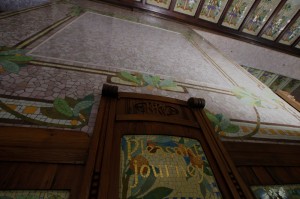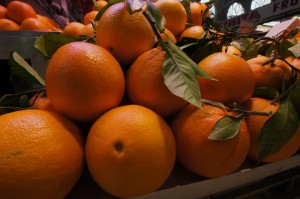Our last road trip was a combination of catching up with friends and trying to get into the minds of some of my creative heroes.
Wherever you travel in Europe someone famous was born there, raised there or lived there.
Trying to get closer to what inspired their work became my focus. Some encounters were planned and others just happened.
We travelled out of Barcelona to Lyon, another of those beautifully preserved French provincial cities.
In the Place des Terreaux is the Bartholdi Fountain.
It was originally created in 1857 for Bordeaux by the then 23 year old, Frédéric-Auguste Bartholdi, the designer of the Statue of Liberty.
Due to budget constraints it was never built there, and that was Lyon’s gain.
Four rampaging horses, the great rivers of France, complete with steaming nostrils, strain against their reins, under the control of an almost placid Paris, depicted as a female figure.
Paul Bocuse, the legendary French chef, is featured along with other heroes of Lyon on the painted facade of a riverside apartment building.
The Basilica of Notre-Dame de Fourviere, built between 1872 and 1884, sits high on the hill overlooking the city. It was undergoing serious internal renovations but beneath the scaffolding were a series of delicate, beautifully crafted, mosaics.
We overnighted at Chateau d’Etoges, in the Champagne region. This grande 17th century residence was once owned by the valet of King Louis XVI. He lost his head during the revolution, as a result of being a little too cosy with the monarchy.
Autumn was well advanced in the Champagne region around Epernay. The vineyards were a patchwork of browns, yellows, reds and greens.
We then headed north into Germany and weather turned even colder.
We picked up Hayden in Mannheim and then drove towards Heidelberg to catch up with our German friends in Bammental.
After an unexpectedly early snowfall the weather brightened up again and the sunflowers were soaking up the last of the Autumn warmth.
From there we travelled further north to Nieder Weisel, the hometown of a brave group of Germans who escaped from the troubles in Europe and took the long voyage to Australia in the 1850s’
Thea’s great, great grandmother was one of them and there’s a plaque near the church that commemorates their feat.
Next was Paderborn, a university town in Germany, where Hayden is spending 4 months as part of his PhD.
We visited, Schloß Neuhaus, just outside the town and situated on the Pader River, the shortest river in Germany. We also scoured Paderborn cathedral in search of the famous ‘Three Hare Window’, but it remained elusive.
We left Hayden to his studies in Paderborn and drove to Nuremberg, home to Albrecht Dürer (1471-1528) Germany’s most famous graphic artist, painter and art theoretician.
There is no original work on display but it’s interesting to visit the house where much of his great art legacy was created.
Nuremberg was also home to the Nazi Party Rally Grounds, covering 11 square kilometers. There is also the Documentation Centre with a permanent exhibition ‘Fascination and Terror’ which provides graphic information about the causes, context and consequences of the National Socialist regime.
Adolf is definitely no hero of mine.
Just on the outskirts of Nuremberg, in Stein, is the factory and family residence of the famous stationery company, Faber-Castell.
I grew up very envious of those kids lucky enough to have a box of their pencils.
Next was Ulm, with the world’s tallest church steeple, and the birthplace of Albert Einstein.
Albert only lived for a short period in Ulm and according to him, it had no impact on his life.
The original house was destroyed in 1945.
The snow was still on the ground in Saint Gallen, Switzerland, and the skies were grey.
The cathedral has recently been restored and has elegant Renaissance frescos on the ceiling and 16 elaborate confessionals.
By my reckoning that gives the church the ability to forgive 32 sinners in a single sitting.
Next was Arnex-sur-Orbe, Switzerland, an idyllic village, where one of my oldest friends has lived, with his family, for nearly 30 years.
From there we visited the ‘Collection de l’Art Brut in Lausanne’ This is a gallery, created in 1976 by the French artist Jean Dubuffet.
He describes what Art Brut is below.
“Art Brut works are produced by self-taught creators firmly entrenched outside the mainstream, harboring a rebellious spirit and impervious to collective norms and values.
These include psychiatric hospital patients, prisoners, eccentrics. loners and outcasts…”
This exhibition was an eye opener with some of the most original and creative, of off-the-wall art, I have seen in years.
Aix-en-Provence and the world of Paul Cezanne was the next stage of our cultural adventure.
There are numerous tours you can do to try and get a insight into the mind of the father of modern painting, or as Picasso described, “the father of us all”
We decided to do just three.
The walk around Aix, with emphasis on where Cezanne lived and studied, Cezanne’s studio on the Lauves Hill and The Painters’ Ground, with spectacular views of Sainte-Victoire Mountain.
We also spent a day just circling around the Aix region, where Sainte-Victoire Mountain is ever present.
Even if you aren’t a student of art, the rugged escarpments of white rock, contrasting with the red earth, is spectacular.
It’s no wonder that Cezanne immortalized the region with his art.
The next leg took us from the sublime to the sometimes absurd, with a three day tour around the Dalí Triangle.
Salvador Dalí’s life embodied the ideals of Surrealism and you can gain a small understanding of this very strange man by visiting three of his most significant buildings.
The Dalí House at Port Lligat was the home that Dalí and his wife, Gala, built over a forty year period. It is a maze of odd shaped rooms on many levels, the result of Dalí buying up the surrounding fisherman’s cottaged and ingeniously combining them together.
You are greeted at the entrance by a giant stuffed polar bear – that sets the tone for the entire house.
Stuffed animals and bizarre objects are a vital ingredient in much of Dalí’s architectural decoration, however he was sane enough to include a BBQ in the back garden, near the pool.
Next was the Theatre Museu Dalí, at Figures, the largest Surrealist object in the world.
The exhibition is housed in what was the former Municipal Theatre, however it was extensively ‘renovated’ to suit the Dalí aesthetic.
Apart from a wide variety of sculptures, paintings and drawings by Dalí, there are also works by other artists.
Like most great artists Dalí studied the Masters and there’s even a reference to Albrecht Dürer’s Rhinoceros in one of Dalí’s etchings.
There is no doubt that this museum was built by Dalí as a homage to himself, as his tomb is in the crypt.
Dalí always fancied himself as the modern Renaissance Man, not confined to one medium or form of self expression. He used film, sculpture, painting, architecture and technology to convey his message.
However it’s his jewelry, in the Dalí-Joies collection, that best demonstrated how his talents could be expressed in alternative ways.
He used many of his reoccurring themes and turned them into beautifully crafted bracelets, broaches and necklaces.
The final part of the triangle was the Casa-Museu Castell Gala Dalí.
This is the 11th century Castle Púbol that Dalí purchased and then renovated as a gift to his wife, Gala. She accepted it on one condition, that Dalí could’t set foot inside the the castle unless he was given a written invitation.
The interior is less extravagant than the other two buildings we visited but still contains many examples of Dalí’s weird sense of humor.
There was no BBQ in the garden but there are some of Dalí’s strange elephant sculptures.
We spent a few hours in Girona on our way back to Barcelona.
Although it has a rich history and has been under siege 25 times, I could’t find any of my heroes in Girona.
*Isaac Newton















A quiet day in Barcelona. (November 2012)
Monday, November 26th, 2012Thea was having her hair cut, and that can take a long time, so I spent four hours wandering around the Gothic Quarter and La Rambla.
What struck me was how quiet everything was.
The streets were free of pedestrians, the shops of customers and the restaurants of diners.
There were still plenty of tourists about but nowhere near as many as we had seen a month earlier.
Even the prized seat, at the front of the double-decker city tour bus, was empty.
The only disturbances to my peaceful stroll, were the graffiti cleaners and the jackhammers of the workers repairing the pavement around the cathedral.
Posted in Comment, Photography | No Comments »